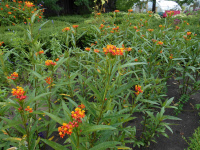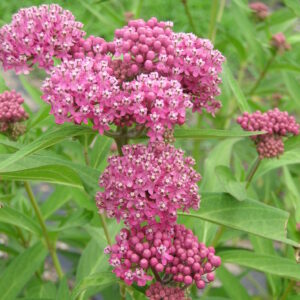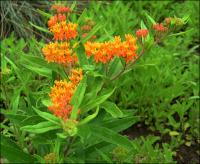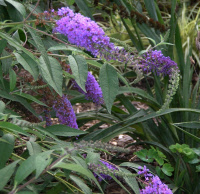…racemosa Bunchberry Cornus canadensis Bush’s coneflower Echinacea paradoxa Butter Bowl Peony Paeonia ‘Butter Bowl’ Butterfly bush Buddleja davidii Butterfly weed Asclepias tuberosa Buttonbush Cephalanthus occidentalis Button snakeroot Liatris aspera Canada…
More »Search Results for: asclepias
-
Asclepias curassavica Bloodflower or scarlet milkweed Z 9-11 Annual in colder areas
Asclepias curassavica grows upright and tall with spiraling lance-shaped leaves. Blooming all summer and early fall. Showy flowers, in small scarlet red and orange umbels....
Asclepias curassavica grows upright and tall with spiraling lance-shaped leaves. Blooming all summer and early fall. Showy flowers, in small scarlet red and orange umbels.
Size: 24-30” x 12-24”
Care: sun to part shade in moist well-drained soil
Native: South America
Wildlife Value: Attracts Monarch butterfliesIn gardens since 1750’s.
-
Asclepias incarnata Swamp milkweed Z 3-9
Fragrant medium pink umbels, like an upside down ballerina’s skirt, July – September.
Fragrant medium pink umbels, like an upside down ballerina’s skirt, July – September.
Size: 3’-4’ x 2-3’
Care: Sun in moist to moist well-drained soil, deer resistant
Native: North America – all states (except along the Pacific coast) & eastern half of Canada, Wisconsin native
Wildlife Value: host for Monarch caterpillars, flowers are source of nectar for several butterfliesNamed after Asclepias, a Greek god of medicine. Native American groups used Swamp milkweed – Chippewa to increase their strength & the stems made into twine; Iroquois to heal navels in babies, to increase or decrease urine and to make a person strong enough to punish witches; Meskwaki to drive out tapeworms; and Menominee used it as an ingredient in food – added to deer soup & cornmeal mush. Listed as growing in England in Miller’s Gardeners’ Dictionary, 1768. Pressed specimen in Emily Dickinson’s herbarium.
-
Asclepias tuberosa Butterfly weed, Pleurisy-root Z 4-9
OUT OF STOCK Gorgeous – July – September bright orange cymes...
OUT OF STOCK
Gorgeous – July – September bright orange cymes
Size: 2-3' x 12"
Care: Sun in moist well-drained to dry soil
Native: East and south North America, Wisconsin native
Wildlife Value: Host for Monarch caterpillars and its nectar is a favorite for 13 different butterflies: 4 Swallowtails, 2 Fritillaries, Checkered white, Spring azure, Small copper, Sachem, Monarch, and Coral and Gray hairstreaks. Attracts Ladybugs that eat many insect pests.
Awards: Great Plants for Great Plains; Perennial Plant Assn. Plant of the Year 2017.Named after Asclepias, a Greek god of medicine. Omaha Indians ate the raw root to cure bronchial and pulmonary ailments, their Shell Society was the authorized guardian of the plant, taking 4 days to dig, prepare and distribute the root. Most important medicine for Menominee Indians. The Iroquois smashed roots on legs to impart strength to runners. Navajo cured coyote bites and flu with Butterfly weed. Millspaugh said used as “subtonic, diaphoretic, alternative, expectorant, diuretic, laxative, escharotic, carminative, anti-spasmodic, anti-pleuritic, stomachic, astringent, anti-rheumatic, anti-syphilitic and what not?” 1st collected by Rev. John Banister in colonial Virginia c. 1680. A gunman mistakenly shot and killed him while he collected plants. Used by natives for Bloody Flux; the Root must be powdered and given in a Spoonful of Rum, or rather as the Indians give it, bruise the Root, and boil it in Water, and drink the Decoction: Pehr Kalm saith it is excellent for the hysteric Passion.” HoChunk placed masticated root into wounds. Cultivated by Jefferson. Pressed specimen in Emily Dickinson’s herbarium.
-
Asclepias verticillata Whorled milkweed Z 4-10 POISON
ARCHIVED Note: This is a plant not currently for sale. This is an archive page preserved for informational use. Fragrant flat-topped clusters of many small white flowers atop single stem...
ARCHIVED
Note: This is a plant not currently for sale. This is an archive page preserved for informational use.
Fragrant flat-topped clusters of many small white flowers atop single stem surrounded by narrow, grass-like leaves. Blooms July through October.
Size: 12-30” x 12-24” spreading
Care: sun to part shade in moist well-drained to well-drained soil
Native: all US, Wisconsin native
Wildlife Value: deer & rabbit resistant. Bees & butterflies eat nectar. Host for Monarch caterpillars.
Size: root used to induce sweating for Choctaw, Chickasaw and Creek nativesCollected by 1753. Grown at America’s 1st botanic garden, Elgin Botanic Garden 1811.
Round Two – Happy Birthday Mr. President
…anemone Aquilegia canadensis Canada columbine Asclepias tuberosa Butterfly weed Calycanthus floridus Carolina allspice Centaurea macrocephala Globe centaurea Ceanothus americanus New Jersey Tea Clematis virginiana Virgin’s bower Anemone sylvestris Windflower Delphinium…
More »Laugh at Walnut Trees
…Adiantum pedatum Maidenhair fern Ajuga – all – Blue bugle Alcea rosea Hollyhock Anemone – all Aristolochia durior Dutchmans pipe Asarum canadense Wild ginger Asclepias tuberosa Butterfly weed Aster –…
More »-
Butterfly Garden for sun
...3 Agastache foeniculum – Anise hyssop 2-3’ x 12” purple 1 Asclepias incarnata – Swamp milkweed 3’-4’ x 2-3’ pink 1 Aster novae angliae – New England aster 3-4’ x...
ARCHIVED
Note: This is a collection not currently for sale. This is an archive page preserved for informational use.
Butterfly Garden for Sun Size : Height x width* Bloom color
3 Agastache foeniculum – Anise hyssop 2-3’ x 12” purple
1 Asclepias incarnata – Swamp milkweed 3’-4’ x 2-3’ pink
1 Aster novae angliae – New England aster 3-4’ x 24” pink or purple
3 Chasmanthium latifolium 36” x 24” green
1 Liatris spicata – Blazing star 2-3’ x 18” purple
1 Lobelia siphilitica – Cardinal flower 3’ x 12” blue
1 Phlox paniculata – Garden phlox 4’ x 2’ spreading magenta
1 Monarda fistulosa – Beebalm 3-4’ x 2’ purple
3 Rudbeckia fulgida – Black-eyed susan 30”x 18” yellow
1 Sedum ‘Autumn Joy’ 30” x 12” pink
3 Verbena bonariensis (reseeding annual) 3-4’ x 6” purple
3 Zizia aurea – Golden alexander 30″x 24″ yellowAll plants are perennials except Verbena bonariensis which is an annual that reseeds.
If planted together in one garden these make a 31 square foot garden.
*Most of these plants get wider over time by spreading roots or by self-seeding .
22 plants for $201.28. Would be $236.80 if purchased separately. You save $35.52.
If you plan on coming to the Nursery to purchase this collection, please give us at least 24 hours notice to prepare the collection for you.






